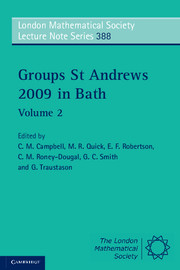Book contents
- Frontmatter
- Contents
- Introduction
- Algorithms for matrix groups
- Residual properties of 1-relator groups
- Words and groups
- The modular isomorphism problem for the groups of order 512
- Recent progress in the symmetric generation of groups
- Discriminating groups: a comprehensive overview
- Extending the Kegel Wielandt theorem through π-decomposable groups
- On the prime graph of a finite group
- Applications of Lie rings with finite cyclic grading
- Pronormal subgroups and transitivity of some subgroup properties
- On Engel and positive laws
- Maximal subgroups of odd index in finite groups with simple classical socle
- Some classic and nearly classic problems on varieties of groups
- Generalizations of the Sylow theorem
- Engel groups
- Lie methods in Engel groups
- On the degree of commutativity of p-groups of maximal class
- Class preserving automorphisms of finite p-groups: a survey
- Symmetric colorings of finite groups
- References
The modular isomorphism problem for the groups of order 512
Published online by Cambridge University Press: 05 July 2011
- Frontmatter
- Contents
- Introduction
- Algorithms for matrix groups
- Residual properties of 1-relator groups
- Words and groups
- The modular isomorphism problem for the groups of order 512
- Recent progress in the symmetric generation of groups
- Discriminating groups: a comprehensive overview
- Extending the Kegel Wielandt theorem through π-decomposable groups
- On the prime graph of a finite group
- Applications of Lie rings with finite cyclic grading
- Pronormal subgroups and transitivity of some subgroup properties
- On Engel and positive laws
- Maximal subgroups of odd index in finite groups with simple classical socle
- Some classic and nearly classic problems on varieties of groups
- Generalizations of the Sylow theorem
- Engel groups
- Lie methods in Engel groups
- On the degree of commutativity of p-groups of maximal class
- Class preserving automorphisms of finite p-groups: a survey
- Symmetric colorings of finite groups
- References
Summary
Abstract
For a prime p, let G be a finite p-group and K a field of characteristic p. The Modular Isomorphism Problem (MIP) asks whether the modular group algebra KG determines the isomorphism type of G. We briefly survey the history of this problem and report on our computer-aided verification of the Modular Isomorphism Problem for the groups of order 512 and the field K with 2 elements.
Introduction
The Modular Isomorphism Problem has been known for more than 50 years. Despite various attempts to prove it or to find a counterexample to it, it is still open and remains one of the challenging problems in the theory of finite p-groups bordering on the theory of associative algebras.
Solutions for the modular isomorphism problem are available for various special types of p-groups. For example, the MIP holds for
abelian p-groups (Deskins [14]; an alternative proof was given by Coleman [12]);
p-groups G of class 2 with G′ elementary abelian (Sandling [34, Theorem 6.25]);
metacyclic p-groups (Bagiński [1] for p > 3; completed by Sandling [36]);
2-groups of maximal class (Carlson [11]; alternative proof by Bagiński [3]);
p-groups G of maximal class, p ≠ 2, where |G| ≤ pp+1 and G contains an abelian maximal subgroup (Caranti and Bagiński [2]);
elementary abelian-by-cyclic groups (Bagiński [4]);
p-groups with the center of index p2 (Drensky [16]); and
p-groups having a cyclic subgroup of index p2 (Baginski and Konovalov [5]).
- Type
- Chapter
- Information
- Groups St Andrews 2009 in Bath , pp. 375 - 383Publisher: Cambridge University PressPrint publication year: 2011
References
- 24
- Cited by



